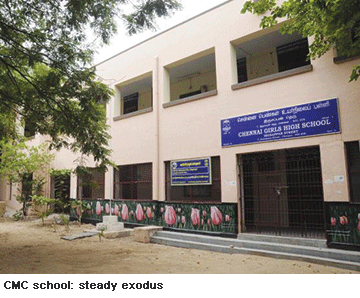DESPITE A 2010 INITIATIVE OF THE Chennai Municipal Corporation (CMC) to rename the primary-upper primary (‘corporation’) schools it runs in the eponymous port city as ‘Chennai Schools’ and “a series of development initiatives” to upgrade teaching-learning standards, their popularity with the public has steadily declined during the past four years. An RTI application filed by the city edition of the Times of India has revealed that 45 of CMC’s 284 schools in Chennai have less than 50 students and seven less than 20 students on their muster rolls. The Chennai Urdu Girls School, Saidapet has just three students and one teacher attending classes, and the Chennai Middle School, Gangapuram and Chennai Primary School, Strahans Road are attended by six and 11 students respectively.
 Declining attendance in corporation schools has embarrassed the AIADMK party which has a majority in the CMC. In February 2014, city mayor Sadai Duraiswamy invited private education trusts to help corporation schools by taking over their management under the charter school model. But the proposal aroused fierce protests from opposition parties and several academics, and failed to take off. As if to reiterate political opposition to any radical reform of the municipal school system, several cadres of the Communist Party of India (Marxist) staged a demonstration on January 7, protesting the gross neglect and closure of 53 corporation schools since 2001 by the CMC. But they simultaneously warned against any attempt to involve private trusts in the management of CMC schools.
Declining attendance in corporation schools has embarrassed the AIADMK party which has a majority in the CMC. In February 2014, city mayor Sadai Duraiswamy invited private education trusts to help corporation schools by taking over their management under the charter school model. But the proposal aroused fierce protests from opposition parties and several academics, and failed to take off. As if to reiterate political opposition to any radical reform of the municipal school system, several cadres of the Communist Party of India (Marxist) staged a demonstration on January 7, protesting the gross neglect and closure of 53 corporation schools since 2001 by the CMC. But they simultaneously warned against any attempt to involve private trusts in the management of CMC schools.
Confronted with a barrage of criticism, the CMC shelved its plans for public-private partnerships. Instead it has deployed headmasters and teachers to go door-to-door to counsel families in their neighbourhood to send their children to CMC schools which they promise will fill existing teacher vacancies, adopt Montessori pedagogy and introduce an English-medium option from class II. However the major problem of CMC schools is the corporation’s poor management of funds allocated for education. In the CMC’s 2013-14 budget of Rs.3,629 crore, Rs.14.50 crore was allocated for education. However, only 34 percent of this modest allocation was spent, prompting the corporation to slash its education budget by two-thirds to Rs.5 crore.
Even of this outlay, only Rs.1.69 crore has been spent.
This is surprising because according to a 2010 study conducted by the outreach department of the government-aided Loyola College, Chennai, which investigated 19 corporation schools with low enrolments, all of them are burdened by dirty, unhygienic toilets with some schools lacking even teachers’ toilets. Moreover, maintenance of school buildings is poor, and drinking water facilities rarely provided. In the circumstances, it’s a mystery why even allocated funds are not spent for infrastructure upgradation and institutional administration.
Little wonder the steady exodus from the state’s 284 corporation and 44,371 government schools to low-cost private budget schools which offer children from poor households better learning outcomes and English-medium education. According to the recently published Annual Status of Education Report 2014, the percentage of children in private schools is steadily rising, and has increased from 29 percent in 2013 to 31.9 percent in 2014.
“The major reason for parents enrolling their children in private schools is the aspiration for English medium education and the prestige associated with studying in fees-levying private schools. Parents believe education in private schools will better equip and prepare their children for employment and the jobs market,” says Sriram Iyer, founder and CEO of the NalandaWay Foundation, a Chennai-based NGO working with corporation schools to equip students with creative, communicative and other life skills.
Clearly, the Tamil Nadu government’s policy of teaching in the Tamil-medium until class V is costing it dearly. The huge and growing demand for English medium education has prompted the state government, which started 640 English medium sections for classes I-VI in 320 school blocks across the state in 2012-13, to start two English-medium sections in all its 44,371 schools.
But this late awakening to obvious demand coupled with poor infrastructure and teaching quality of government and corporation schools, indicates the flight to private schools will continue.
Charter schools — endorsed by EducationWorld (see EW cover story August 2014) — may soon be back on the CMC agenda.
Hemalatha Raghupathi (Chennai)